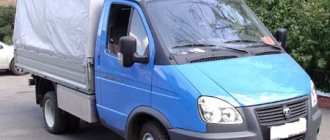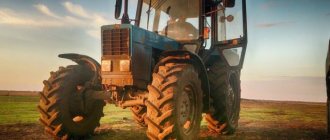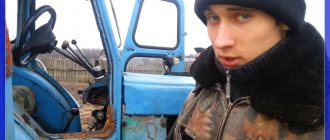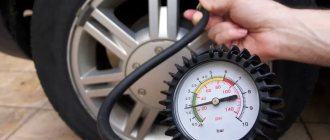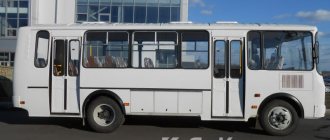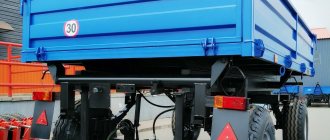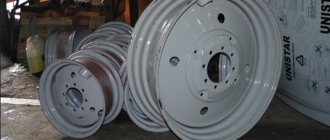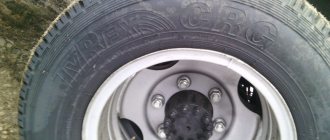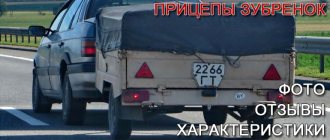Review of the best tire models for ZIL
The legendary truck that began its life under the USSR is ZIL. The plant produced trucks to meet all the requirements that could arise: truck cranes, truck tractors, refrigerators, vans and a huge number of other varieties. ZIL is known not only for its trucks and government cars - Kamaz began its journey at ZIL factories. Now only a few people remember this, but it was at ZIL that Kamaz received its first versions of cars that formed the basis of the modern automotive industry. But, like any car, trucks require high-quality tires to move and deliver goods.
Characteristics
A huge selection of additional equipment was offered for ZIL trucks, which made the vehicle universal for all areas of operation. The machine could be used to transport goods, and the version with a crane could be used for construction and utility purposes.
The truck was equipped with a 6.0 liter V-shaped engine with 8 cylinders and a two-chamber carburetor. Output power of 150 hp. it was enough for a load capacity of 6 tons, and it allowed it to confidently perform the functions of a medium-tonnage truck.
Further modifications of the truck were produced with a modified version of the ZIL-130 engine. Most improvements consisted of adapting the motor to various conditions (faster acceleration, greater load capacity, etc.).
Modified version of the ZIL-130 engine
Refill tanks
The car's refueling capacities are quite large, and this is justified by the engine power and its purpose:
In our article you can understand the technical characteristics of the KamAZ-53215, as well as find out what equipment can be installed on its chassis.
By clicking on the following link https://spez-tech.com/tehnika/raznoe/kak-burit-skvazhinu-na-vodu-svoimi-rukami.html, you will find information about drilling a water well with your own hands, and you can also watch a video about this theme.
Selection
What tire characteristics must be observed when choosing tires for trucks? To choose the right tires, you must follow the recommended size of ZIL tires, and during operation, strictly monitor the pressure indicator in ZIL tires. By following these two rules, the tires will last a long time without requiring replacement.
Standard size
The size must be selected in accordance with the selected configuration and body. For certain conditions, the factory has selected special wheel sizes that ensure travel in certain conditions (off-road, etc.). You can find information in the vehicle's operating instructions.
User manual
For the most common models, the standard size is:
Tire ZIL Bychok 5301
It is necessary to comply with the specified standard sizes so that the center of gravity does not shift and the tires do not wear out quickly.
Pressure
Another of the main indicators that must be observed during operation is pressure. The performance and softness of the suspension, tire service life and a number of other parameters depend on the pressure characteristics. It must be remembered that when the tires are fully loaded, it is necessary to inflate or deflate so that the machine does not sag under the load and “chew” the tire.
For popular models, the pressure should be:
Due to the age of the ZIL-157, the pressure is selected individually.
Important: the values are indicated for cars without load, operating in the summer!
Engine Description
The truck in question was equipped with several types of engines at different times:
From April 2008 to the present day, all ZIL-5301 models are equipped with engines that meet Euro 3 requirements in terms of their environmental qualities.
After reading this article, you will be convinced that buying a used Hovo dump truck in many cases is much more profitable than purchasing a new one.
The MMZ D-245.9 engine has the following characteristics:
The engine in question, among other things, is equipped with a turbocharger - this is one of the reasons for such high power. The design involves cooling the air before blowing (intermediate).
The overall dimensions of the motor are relatively small, despite years of development:
Consumption is approximately 12 liters for every 100 km at a speed of no more than 60 km/h.
“Bychok” is quite fast and can compete even with its foreign counterparts: the maximum speed with maximum load, according to the accompanying documentation, is 95 km/h.
Replacement
To replace standard ZIL wheels, the following options, which have proven themselves only on the positive side, are ideal:
The bottom line can be summed up as follows: in order for the legendary truck to continue to drive and perform its direct functions, its condition needs to be monitored, and one of the main elements that need constant monitoring is the tires. If you take proper care of your tires, your car will repay it with a long service life and will get you anywhere you need to go!
Source
Tire pressure in Zila Bychke
ZIL-5301 Bull. WHEELS AND TIRES
The car is equipped with steel, disc, stamped wheels of size 6.5J-16H2. The wheels are aligned using the central hole. The wheels are attached to the hubs with six bolts M 18×1.5
On a new car and every time you remove the wheels, you need to tighten the wheel nuts crosswise every 100-150 km until the torque stabilizes. The tightening torque of the wheel nuts should be 360.440 N.m
In the future, the tightening torque of the nuts will stabilize and tightening them during regular checks is not required.
Removing a tire from a wheel should be done mainly on special stands and only in exceptional cases manually.
Attention! Before dismantling the outer rear wheel, you must release the inner wheel valve extension from its mounting bracket.
If necessary, in case of uneven tire wear, the wheels should be rearranged according to the diagram shown in Fig. 25.
It is not allowed to operate tires when the tread is worn to a tread height of less than 1 mm or to the wear indicator on the tire tread. Tire wear indicators are located along the bottom of the tread pattern grooves in its central part in six zones. The section where the wear indicators are located has the letter “TWI” on the sidewall.
Rice. 25. Wheel rearrangement scheme
Dismantling the tire must be done carefully, without much effort, avoiding damage to the beads. Dismantling should begin from the valve, moving the blades short distances. In case of significant damage, the tire must be replaced.
Before mounting a tubeless tire, the wheel must be carefully inspected and checked. The wheels must not be bent, have deep scratches, weld beads or corrosion. Wheels should be well painted.
Particular attention should be paid to preparing the surface of the shelves and beads of the wheel, that is, the places where the tubeless tire fits tightly on the wheel.
Before installing the valve into the wheel, you must put a rubber O-ring on its body, then insert it into the wheel hole from the inside and tighten the nut from the outside.
Before mounting a new tubeless tire, you must remove the spacers and lubricate the tire beads, as well as the flanges and beads of the wheel with a soapy solution.
When installing a tire on a wheel, you need to ensure that the balancing mark on the tire, indicating its lightest part, is located at the valve to partially compensate for the tire imbalance with the weight of the valve.
.Installation must be done carefully, without much effort, avoiding damage to the wheel beads and tires. Mounting blades must be smooth and clean, without nicks. Filling the tire beads onto the wheel should begin from the side opposite the valve, approaching it evenly from both sides and moving the mounting blades short distances.
To create the tightness necessary for inflating the tire, it is necessary to ensure that the tire beads are pre-seated on the wheel flanges. To do this, the tire must be compressed along the tread using a special tightening tape or by twisting a strong rope.
Sometimes, after installation, it is enough to tap the tire on the rim so that the tire sides move apart somewhat.
Inflate the compressed tire (from the compressor) with the spool turned out. After the tire beads are firmly seated in place, the tensioning device must be removed.
To fully seat the beads on the wheel, the tire must be inflated to a pressure of 0.6. 0.7 MPa, then screw in the valve spool and maintain the tire at the specified pressure for 30 minutes, then reduce the pressure to normal.
To check the tightness of the tire, you need to lower the wheel with the inflated tire into a bath of water and watch for air bubbles appearing at the tire beads, at the valve attachment point and on the outer surface of the wheel.
The tightness of the tire fit on the wheel can also be checked by pouring water between the tire beads and the beads of a horizontally lying wheel.
When operating a car, it is necessary to regularly monitor the air pressure in the tires, since driving a car with low tire pressure leads to their rapid wear and destruction. It is impossible to reduce the air pressure in tires, which has increased due to their heating when the car is moving.
Checking the air pressure in tires should be done on cold tires. To make this operation easier, the rear dual wheels are equipped with an inner wheel valve extension. Parking a vehicle with flat tires is not permitted.
In addition to the features set out in this manual, the current general rules for operating car tires must be observed.
It is possible to install a tube of the appropriate size into the tire.
Source
Specifications
Zil bull began to be produced in 1996. It received the name goby thanks to popular rumor and some similarities. ZIL "Bychok" is the founder of the fifth generation of medium-duty trucks.
Technical characteristics of ZIL 5301
Weight of transported cargo, kg 3450 Weight of curbed vehicle, kg 3350 Distribution of load on the road from curb weight through tires, N (kgf): front wheels 19000 (1900) rear axle 14500 (1450) Permissible gross vehicle weight, kg 6950 Permissible road loads from the total weight through the tires, N (kgf): front wheels 23500 (2350)* rear axle 49000 (4900) Internal platform dimensions, mm 3750x2254x450 Turning radius, m 7.8 Maximum speed, km/h 95 * redistribution of maximum axle loads must correspond to a total weight of 6950 kg
Engine
Model MMZ D-245.9 E3 Type diesel with turbocharging and intermediate air cooling Displacement, l 4.75 Power, hp/kW 95.7/130 at min-1 2400
Clutch Single disc
Gearbox Five-speed
Drive axle Single stage hypoid
Cardan drive Two cardan shafts with three joints, a sliding spline and an intermediate support
Wheels and tires Disc wheels 6.5Jx16H2, Tubeless tires 225/75R16С
Steering mechanism With built-in hydraulic booster
Brakes Front disc Rear drum
Electrical equipment Single-wire system with a rated voltage of 24V.
Cab Double, extended, two-door with two berths
The truck is equipped with a tractor diesel engine, which has 4 cylinders and develops a power of 109 hp. The engine for Bychka is supplied by the Minsk Motor Plant. The cabin is designed for 3 people, including the driver, and has some similarities with the ZIL-4331 cabin. The truck also has a power steering mechanism, the clutch and brake mechanisms are hydraulically driven.
The main gear is hypoid. Disc brakes are installed on the front wheels, drum brakes are installed on the rear wheels. The gearbox is manual and has five stages. The wheels reach 16 inches in diameter and are equipped with tubeless tires. The truck has a turning radius of 7 meters. The vehicle weighs approximately 4 tons. The maximum speed that a truck can reach is 95 km/h.
The truck can carry up to 3 tons of cargo, while its maximum weight should not exceed 6950 kg. The front wheels can be loaded up to 2350 kg, the rear wheels up to 4900 kg. The metal platform, which is equipped with an awning, has the following internal dimensions: length - 3.75 m, width - 2.215 m, height - 0.49 m. At a speed of 60 km/h, the Bychok truck consumes 100 km. 12 liters of diesel fuel. And up to this 60 km/h “Bychok” can accelerate in 30 seconds. The diesel engine is brand MMZ D-245.12.
There are several varieties of “Bull”, these include trucks equipped with a short, extended or double cab, which is designed for 7 people. On such a steer you can install sides with a capacity of up to 3, 2.9 and 2.7 tons. Bychok trucks are also produced as a van type and can be used as refrigerators or an isothermal van.
Since 1998, the production of “Bull” began, which has a solid metal van. In the city you can find specialized "Bull" trucks, such as dump trucks, tanks, tow trucks, fire trucks and even buses. A 3-axle “Bull” is also produced, with only the rear wheels remaining driving; there is also an all-wheel drive “Bull” with a 4x4 wheel arrangement.
| Body ZIL 5301 | ||
| Body type | Truck | |
| Number of seats | 3 | |
| Number of doors | 2 | |
| Engine MMZ D-245 ZIL 5301 | ||
| Engine capacity, cubic meters cm | 4750 | |
| Supply system | Diesel with turbocharging and intercooling | |
| Cylinder diameter | 100 | |
| Number of cylinders | 4 | |
| Piston stroke | 95 | |
| Compression ratio | 7.1 | |
| Power hp | 136 | |
| Fuel brand | DT | |
| Transmission ZIL 5301 | ||
| Drive unit | 4x2 | |
| Clutch | Single disk | |
| Transmission | 5-speed, manual | |
| Gear ratio of the main pair | 6,32 | |
| Suspension and steering ZIL 5301 | ||
| Steering type | A screw with a ball nut and a piston-rack engaging with the toothed sector of the bipod shaft | |
| Front suspension type | On two semi-elliptic springs with rear sliding ends, two shock absorbers | |
| Rear suspension type | On two main and two additional semi-elliptic springs | |
| Brake system ZIL 5301 | ||
| Front brakes | Disk | |
| Rear brakes | Drums | |
| Wheels ZIL 5301 | ||
| Tires | 225/75 R16С | |
| Discs | R16 | |
| Electrics ZIL 5301 | ||
| Battery | 6ST-110TR | |
| Candles | 11.721.083 | |
| Low and high beam lamp | TN 114 | |
| Generator | 1652.3701 | |
| Starter | 74.3708000 | |
| Relay regulator | 206/207.3702 | |
| Refill containers (liter) ZIL 5301 | ||
| Fuel tank | 125 l. | DT |
| Engine cooling system | 16 l. | Antifreeze A-40 |
| Oil | 18 l. | M-6/10V |
| Gearbox oil | 5 l. | TSp-15K |
| Oil in the rear axle housing | 3.3 l. | TSp-14gip |
| Steering gear oil | 3.2 l. | TMP-10 oil |
| Clutch fluid | 0.4 l. | Brake fluid "Tom", "Neva" |
| Brake fluid | 1 l. | Brake fluid "Tom", "Neva" |
| Washer (anti-freeze) | 2.7 l. | NIISS-4 |
Tire pressure ZIL 130, ZIL 131
Before leaving for a new trip, every truck driver must check the tire pressure on ZIL 130, 131, 4331 and other modifications. This is an important indicator, since under load certain difficulties and emergency situations may arise. Sometimes you have to pump up and down more to overcome dangerous areas in winter. Many ZIL trucks, including those, have an automatic inflation system that maintains this indicator in all wheels at a given value.
Features of monitoring and regulating tire pressure
The tire pressure on the ZIL 131 and other modifications of the car must be constant. A deviation of no more than 0.2 kg/cm2 is allowed. round trip. If the difference is greater, then driving such a car is unsafe and ineffective. For example, with reduced pressure, an additional load occurs, which leads to increased fuel consumption, accelerated tire wear and overheating.
The peculiarity of this brand of car is that the pressure in the tires of a ZIL bull or other truck directly depends on the braking system, since they are combined. There are automatic inflation devices on each wheel, with which you can control and change it directly from the cab. So, the air pressure in the general system must be maintained at a constant level, the values correspond to figures of 5-6 kg/cm2. The adjustment is carried out using a built-in compressor, which starts when the engine is running.
Transmission and chassis
The car in question is equipped with a five-speed manual gearbox.
The main gear type is hypoid. The clutch is standard, disc, in an oil bath. There is a synchronizer that operates in all gears (including reverse), with the exception of 1st and 3rd.
The wheels are standard (6.5j×16H2) in the form of stamped discs made of high-strength metal. The alloy has a fairly high hardness, which allows the discs to withstand even extreme loads without any problems.
Considering that they are used on a truck, this is an important factor. Stamped wheels are fitted with regular tubeless tires - 227/75R16C.
The main transmission mechanism is a cardan transmission, equipped with three hinges, an intermediate support, and a sliding spline connection.
The impact on the road surface of an unloaded vehicle through tires is distributed as follows:
The load on the road surface of a loaded truck is:
The steering is equipped with a hydraulic booster, which greatly simplifies maneuvering.
Advantages of an automatic pressure control system
You can control and regulate tire pressure on ZIL 4331 and other modifications using a special device. It is a pressure control valve with a spool-type limiting valve. A head for supplying air to the tires is installed in the wheels. The presence of such a system provides the car with certain advantages in motion:
In addition to the valve and head for air supply, the system also contains a tire valve. It is located in a socket on the axle shafts. With its help, you can forcefully open the air supply channel or completely block it.
What pressure should be in ZIL 130 tires is indicated in the technical documentation for the car, but it is also worth taking into account operating conditions and load. If the road is slippery, then it is better to lower it, thereby making the wheels softer and increasing the contact patch with the surface.
Source
Brake system
The car in question is equipped with a dual-circuit braking system. Each circuit is completely independent. One of them brakes the front right and rear left wheels.
The second is front left and rear right. Thus, maximum safety on the road is achieved: even if one of the system components fails, emergency braking remains quite possible.
The brakes are operated hydraulically. Air amplifier (pneumatic). There is also a handbrake; it is mechanically connected (with a steel cable) to the rear mechanisms. The brakes have the following design:
The latest models, released recently, are equipped with an anti-lock braking system (ABS).
One of the models of a light-duty truck from the Mercedes Benz concern called Vario was used as a prototype of the car.
The design of the frame was inherited from him - a ladder type, in which there are spars with a “channel” type section.
Such design features allow the Bull to be quite safe, since even in a head-on collision at high speed, the likelihood of the frame structure folding is minimal. The frame has the following overall dimensions:
There is a special device in the front part of the frame that allows you to tow the car.
What pressure should be in the tires zil bychok
Array ( [DATE_ACTIVE_FROM] => 12/15/2020 23:33:00 [
DATE_ACTIVE_FROM] => 12/15/2020 23:33:00 [ID] => 510053042 [
ID] => 510053042 [NAME] => Tire pressure ZIL 130, ZIL 131 [
NAME] => Tire pressure ZIL 130, ZIL 131 [IBLOCK_ID] => 33 [
IBLOCK_ID] => 33 [IBLOCK_SECTION_ID] => [
IBLOCK_SECTION_ID] => [DETAIL_TEXT] => Before leaving for a new trip, every truck driver must check the tire pressure on ZIL 130, 131, 4331 and other modifications. This is an important indicator, since under load certain difficulties and emergency situations may arise. Sometimes you have to pump up and down more to overcome dangerous areas in winter. Many ZIL trucks, including those, have an automatic inflation system that maintains this indicator in all wheels at a given value. Operating tires with low pressure leads to rapid wear and overheating. The optimal value of air pressure in the wheels is 3.% for the front wheels and 4.3-5 for the rear wheels. In particular, the tire pressure on a ZIL 130 dump truck should be 4.3 bar. For modifications ZIL-130G, ZIL-ShV1 and ZIL-130, the optimal pressure value is a reading of 5 bar.
Features of monitoring and regulating tire pressure
The tire pressure on the ZIL 131 and other modifications of the car must be constant. A deviation of no more than 0.2 kg/cm2 is allowed. round trip. If the difference is greater, then driving such a car is unsafe and ineffective. For example, with reduced pressure, an additional load occurs, which leads to increased fuel consumption, accelerated tire wear and overheating. The peculiarity of this brand of car is that the pressure in the tires of a ZIL bull or other truck directly depends on the braking system, since they are combined. There are automatic inflation devices on each wheel, with which you can control and change it directly from the cab. So, the air pressure in the general system must be maintained at a constant level, the values correspond to figures of 5-6 kg/cm2. The adjustment is carried out using a built-in compressor, which starts when the engine is running.
Chronic diseases ZIL 5301. Owner reviews
There are no ideal cars, but preventing “diseases” allows you to operate the vehicle for a long time, especially when it comes to commercial vehicles.
This statement is confirmed by reviews published online. ZIL Bychok 5301 has a number of disadvantages, some of which are related to the human factor, and some to technical problems inherent in the domestic automobile industry. First of all, it should be noted that the paintwork of the cabin does not stand up to criticism. Already during the first month of operation, you can observe paint peeling off the hood of a ZIL 5301 truck. Photos of short-term used vehicles offered for sale on automobile portals are indisputable proof of this fact. You can judge the most common problems in more detail by studying multiple reviews.
If the owner purchased autonomous heating for an additional fee, then attention should be paid to the durability of the system and the lack of a separate warranty for the unit. As for the cabin, the hatch built into the roof is quite convenient, but in most cases it leaks.
In winter, vehicle owners report difficulty starting. This problem can only be solved by carefully preparing the fuel and starting systems. In addition, there are problems in dismantling the cooling radiator and the complexity of the process of replacing the air filter.
When operating a vehicle with overload, the tires of the wheels tear, but the load on the engine is not felt.
It is not recommended to skimp on the quality of fuels and lubricants during operation. In addition to the engine and transmission, it is necessary to periodically service the rear axle. ZIL 5301 is a model that is the most expensive to maintain among all models of the car plant. It is recommended to change the engine oil every 10,000 km, and replace it in the box after 30,000 km. The rear axle with gearbox from the 130th model has a number of problems:
- cracking of crosspieces;
- coloring satellites;
- differential gear defects.
Improper maintenance of the elements of the rear drive axle leads to the replacement of the entire ZIL 5301 unit. Video materials showing the results of vehicle operation confirm the serial breakdown. Owners and maintenance personnel are recommended to carry out maintenance taking into account faults identified by many years of experience, and not use the saying that a good knock will come out on its own. Usually, the occurrence of breakdowns “pulls” others with them and the cost of maintenance and repairs increases significantly.
Characteristics
A huge selection of additional equipment was offered for ZIL trucks, which made the vehicle universal for all areas of operation. The machine could be used to transport goods, and the version with a crane could be used for construction and utility purposes.
The truck was equipped with a 6.0 liter V-shaped engine with 8 cylinders and a two-chamber carburetor. Output power of 150 hp. it was enough for a load capacity of 6 tons, and it allowed it to confidently perform the functions of a medium-tonnage truck.
Further modifications of the truck were produced with a modified version of the ZIL-130 engine. Most improvements consisted of adapting the motor to various conditions (faster acceleration, greater load capacity, etc.).
Modified version of the ZIL-130 engine
Pneumatic tires.
They are very important parts. And their purpose is varied. Tires carry the weight load, provide traction, absorb traction and braking forces, and absorb shocks and shocks that occur when the vehicle is moving.
The complexity and magnitude of the load experienced by tires during operation have caused increased demands on their design and the quality of the materials from which they are made.
Car tires are made from rubber, special fabric and steel wire. Rubber is made from synthetic or natural rubber mixed with a number of other substances called ingredients: carbon black, kaolin, sulfur, chalk, etc.
Raw rubber, i.e. a mixture of rubber with ingredients, undergoes so-called vulcanization by heating to a temperature of 130-145 ° C, during which a chemical combination of rubber and sulfur occurs. After vulcanization, raw rubber acquires new mechanical properties: it becomes very elastic (when stretched, it elongates almost 10 times), elastic and quite durable. There are many types of rubber, several of which are used to make tires.
Tire manufacturing
Special fabrics are also used for tires: cord, a rubberized fabric in which the threads are arranged parallel and do not intertwine, and plain weave fabrics - chafer for fenders and reinforcing tapes of tire beads, modestic and calico - for wrapping tire rings.
Cord, the threads of which are made from viscose, polymer materials or cotton, is used for the main and most important part of the tire - its frame. For especially durable and critical tires, the cord is made of woven metal threads (metal cord) and specially manufactured polyamide materials.
Tires of various designs have been developed and used to ensure the operation of vehicles in various operating conditions (Table 16).
The most common tires are low pressure tires, called balloon tires. They create a small specific pressure on the road, and on soft soils they improve the vehicle's maneuverability.
Advantages of an automatic pressure control system
You can control and regulate tire pressure on ZIL 4331 and other modifications using a special device. It is a pressure control valve with a spool-type limiting valve. A head for supplying air to the tires is installed in the wheels. The presence of such a system provides the car with certain advantages in motion:
In addition to the valve and head for air supply, the system also contains a tire valve. It is located in a socket on the axle shafts. With its help, you can forcefully open the air supply channel or completely block it. What pressure should be in ZIL 130 tires is indicated in the technical documentation for the car, but it is also worth taking into account operating conditions and load. If the road is slippery, then it is better to lower it, thereby making the wheels softer and increasing the contact patch with the surface. [
Weight and dimensions parameters
ZIL-5301 is a light-duty vehicle, but even taking this into account, we can say that it is very compact. Its overall dimensions are as follows:
Overall dimensions may vary greatly depending on the specific modification of the car. For example, ZIL-5301 TO has a length of 7,165 mm - almost a whole meter longer than usual. And for the AO modification, these technical characteristics are identical to the base model.
The weight of the car itself, without cargo, is small, which is a very big advantage - if necessary, you can easily overcome almost all engineering communications:
The ground clearance is relatively small, especially compared to its peers, and is only 180 mm. This is usually not enough for comfortable travel on country roads or rough terrain.
That is why the ZIL-5301 “Bychok” is positioned as an urban light-duty truck.
The advantages of dimensional characteristics also include small tracks of the front and rear wheels:
Weight characteristics of individual components and assemblies:
Features of monitoring and regulating tire pressure
The tire pressure on the ZIL 131 and other modifications of the car must be constant. A deviation of no more than 0.2 kg/cm2 is allowed. round trip. If the difference is greater, then driving such a car is unsafe and ineffective. For example, with reduced pressure, an additional load occurs, which leads to increased fuel consumption, accelerated tire wear and overheating. The peculiarity of this brand of car is that the pressure in the tires of a ZIL bull or other truck directly depends on the braking system, since they are combined. There are automatic inflation devices on each wheel, with which you can control and change it directly from the cab. So, the air pressure in the general system must be maintained at a constant level, the values correspond to figures of 5-6 kg/cm2. The adjustment is carried out using a built-in compressor, which starts when the engine is running.
